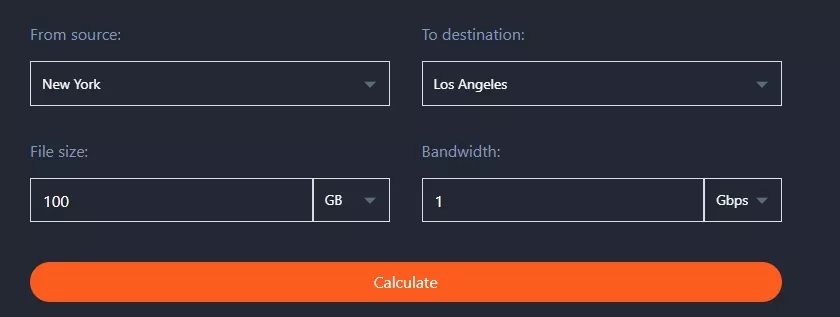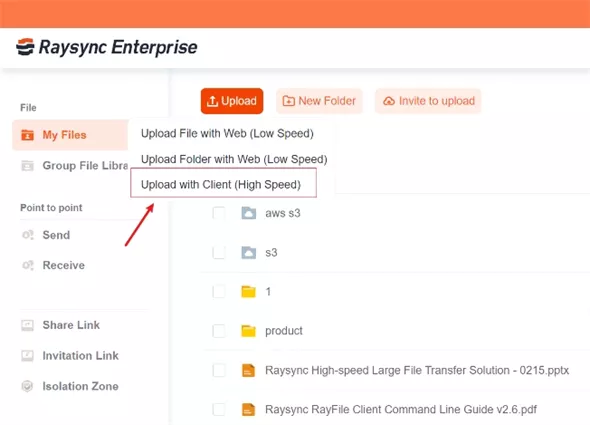Fastest Way to Send Video Files [100GB in Just 13 Minutes]
June 21, 2024Sending large video files quickly is a challenge many face, whether for professional or personal use. Traditional methods like email attachments or standard cloud services can be slow and cumbersome, often taking hours or even days to transfer high-quality videos.
However, using advanced file transfer solutions is the fastest way to send large video files, making it possible to send 100GB of video data in just 13 minutes. In this blog post we will explore these advanced methods.

How to Estimate File Transfer Duration
Estimating file transfer duration is essential for efficient data management. To calculate this, you need to know the source and destination locations, file size, and available bandwidth in megabits per second (Mbps).
By inputting these details into a file transfer calculator, you can get an accurate estimate of the transfer time. Raysync offers a reliable calculator that provides precise estimations, ensuring you can plan your transfers effectively.

This tool is particularly useful for large file transfers, helping you optimise your bandwidth and reduce downtime to find the fastest way to share large video files.
What Is the Fastest Way to Send Video Files [From 1GB to 1000 TB]
Sending large video files quickly can be challenging due to limitations in traditional file transfer protocols. Standard methods often struggle with bandwidth utilization, packet loss, and latency issues, which significantly slow down transfer speeds. As video files increase in size—from 1GB to 1000TB—the inefficiencies of conventional protocols become even more pronounced.
To address these challenges, it's essential to use a protocol designed for high-speed, reliable data transfers. The Raysync Protocol stands out as the fastest way to share large video files. It leverages innovative congestion detection and control mechanisms to maintain optimal transmission speeds even in the presence of network disruptions.
Unlike traditional TCP, which suffers from reduced speeds in high-latency and high-packet-loss environments, Raysync ensures efficient bandwidth usage and minimal transfer times. Its design allows it to bypass the typical bottlenecks associated with older protocols, making it the most efficient method for transferring video files ranging from 1GB to 1000TB. Whether you're dealing with small clips or massive libraries, Raysync Protocol ensures your videos are sent quickly and reliably.
Steps of Fastest Way to Send Video Files
Want to send video files lightning-fast? Raysync's high-speed transfer protocol utilizes your available bandwidth to its fullest, significantly accelerating transfers compared to traditional methods.
Here's how to get started with Raysync:
- Click the Free Trial Button: Visit the Raysync website and click the "Free Trial" button. Fill in the information and submit the request. Our technical support team will contact you ASAP.
- Configure Raysync Settings: Our support team will assist in configuring the transmission settings according to your network environment. Adjust parameters such as bandwidth allocation, maximum file size, and concurrency settings to optimize performance.
- Start the File Transfer: Upload the video files first. And then select the video files you want to send. Choose the destination and initiate the transfer. Raysync will handle the rest, utilizing its high-speed transmission protocol to ensure the fastest transfer times.

By using Raysync, you can bypass the limitations of traditional file transfer methods and achieve optimal speeds, even with extremely large video files. Its advanced technology ensures efficient, reliable transfers, making it the fastest way to send video of any size. Learn more about Raysync via video:
FAQs about Fastest Way to Send Video Files
Get answers to some of the many frequently asked questions about the fastest way to send video files:
1. How can I send long videos fast?
To send long videos quickly, you need a reliable and fast transfer method.
Here are the steps:
- Choose a High-Speed Transfer Service: Use a service designed for fast transfers, like Raysync, which optimizes data transmission.
- Compress the Video: Compress your video to reduce its size without compromising quality. This step is optional but can speed up the process.
- Upload and Share: Upload the video to the chosen service and share the link with the recipient.
Using Raysync, you can take advantage of their advanced protocol to send large video files efficiently, ensuring quick and secure delivery.
2. How do I transfer large video files?
Transferring large video files requires an efficient approach to ensure speed and reliability.
Here’s how to go about it:
- Choose a Reliable Transfer Method: Opt for a service or protocol designed for large file transfers, such as Raysync, known for its fast speeds.
- Prepare Your Files: Ensure your video files are organized and ready for transfer to streamline the process.
- Use Compression (Optional): Compressing files can reduce size and speed up transfer times, though quality may be slightly affected.
- Initiate Transfer: Upload your video files using the chosen method and share the download link or recipient details for seamless delivery.
Raysync’s advanced protocol guarantees fast and secure transmission, the fastest way to share large video files with minimal hassle and maximum efficiency.
3. How do I email videos that are too large?
Email services often have file size limitations, making it challenging to send large videos.
Here’s a practical method to overcome this:
- Use Cloud Storage: Upload the video to a cloud storage service like Google Drive, Dropbox, or OneDrive.
- Generate Shareable Link: Create a shareable link for the video file in the cloud storage platform.
- Share the Link: Copy the link and paste it into your email. Ensure that the link settings allow anyone with the link to view or download the file.
- Notify Recipient: Inform the recipient about the email and provide instructions on accessing the shared link.
By leveraging cloud storage and shareable links, you can easily bypass email size restrictions and efficiently share large video files.
The End
In this post, we'll explore the fastest way to send video files. What matters most are optimizing bandwidth utilization and minimizing packet loss. If you frequently deal with large video files and require top-tier transfer speeds, consider exploring specialized services designed for this purpose.
You might also like

Industry news
October 23, 2024Explore the top ftp clients featuring advanced capabilities, robust security, and optimal performance across all platforms.

Industry news
February 28, 2025Struggling with cross-platform file transfers? Learn how to use Rsync, or explore faster, easier alternatives. We cover the challenges and solutions for seamless data movement between Windows and Linux systems.
![Best 3 Massive File Transfers [from 1GB to 100TB]](http://images.ctfassets.net/iz0mtfla8bmk/3A84sM4E1xrOD65h1ikuOv/f46a742aa9f1eaf13b5800360757d54c/massive-file-transfer.png)
Industry news
June 5, 2024To send big files was never an easy task. Thanks to modern technology, now it's achievable and easier than it ever was. Let’s see how these massive file transfers have revolutionized the world of file sharing.